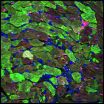Wild blueberries (bilberries) can help tackle the adverse effects of a high-fat diet
2014-12-18
(Press-News.org) Eating bilberries diminishes the adverse effects of a high-fat diet, according to a recent study at the University of Eastern Finland. For the first time, bilberries were shown to have beneficial effects on both blood pressure and nutrition-derived inflammatory responses.
Low-grade inflammation and elevated blood pressure are often associated with obesity-related diseases. The study focused on the health effects of bilberries on mice that were fed high-fat diet for a period of three months. Some of the mice were fed either 5% or 10% of freeze-dried bilberries in the diet. The researchers assessed the effects of the diets by looking at inflammatory cell and cytokine levels, systolic blood pressure, glucose tolerance, insulin sensitivity and weight gain.
Mice on the high-fat diet experienced significant weight gain and detrimental changes in glucose and lipid metabolism, inflammation factors and blood pressure. Bilberries diminished the pro-inflammatory effects of the high-fat diet, indicated by an altered cytokine profile and a reduced relative prevalence of inflammation supporting T-cells. Bilberries also prevented elevated blood pressure caused by the high-fat diet.
Bilberries constitute an integral part of the Nordic diet and they could be better utilized also elsewhere in the world. Bilberries are associated with several beneficial health effects and their use involves plenty of traditional wisdom. The beneficial health effects of bilberries are thought to be explained by polyphenols, especially anthocyanins, the levels of which are significantly higher in bilberries than in commercially cultivated blueberries.
The original article was published in PLOS ONE, and it is openly accessible at http://dx.plos.org/10.1371/journal.pone.0114790
INFORMATION:
For further information, please contact:
Otto Mykkänen, MSc, (otto.mykkanen(at)uef.fi, tel. +358405635220)
Pirkka Kirjavainen, PhD, Docent (pirkka.kirjavainen(at)thl.fi, tel. +358405090449)
ELSE PRESS RELEASES FROM THIS DATE:
2014-12-18
The enzyme telomerase repairs cell damage produced by ageing, and has been used successfully in therapies to lengthen the life of mice. Now it has been observed that it could also be used to cure illnesses related to the ageing process. Researchers at the Spanish National Cancer Research Centre (CNIO) have for the first time treated myocardial infarction with telomerase by designing a very innovative strategy: a gene therapy that reactivates the telomerase gene only in the heart of adult mice, thus increasing survival rates in those animals by 17 % following a heart attack.
Christian ...
2014-12-18
Researchers from North Carolina State University have found a way of binding peptides to the surface of gallium nitride (GaN) in a way that keeps the peptides stable even when exposed to water and radiation. The discovery moves researchers one step closer to developing a new range of biosensors for use in medical and biological research applications.
GaN is a biocompatible material that fluoresces, or lights up, when exposed to radiation. Researchers are interested in taking advantage of this characteristic to make biosensors that can sense specific molecules, or "analytes," ...
2014-12-18
This news release is available in German.
Physicists are continuously advancing the control they can exert over matter. A German-Spanish team working with researchers from the Max Planck Institute for Nuclear Physics in Heidelberg has now become the first to image the motion of the two electrons in a helium atom and even to control this electronic partner dance. The scientists are succeeding in this task with the aid of different laser pulses which they timed very accurately with respect to each other. They employed a combination of visible flashes of light and ...
2014-12-18
Trophoblasts, cells that form an outer layer around a fertilized egg and develop into the major part of the placenta, have now been shown to respond to inflammatory danger signals, researchers from Norwegian University of Science and Technology (NTNU) found in a recent study published in Journal of Reproductive Immunology December 2014.
The researchers said their findings were an important step in understanding how inflammatory responses in the placenta can contribute to the development of pregnancy disorders such as preeclampsia.
The trophoblast inflammatory response ...
2014-12-18
This news release is available in German.
Puebla del Guzman (Andalusia) / Magdeburg. Being part of the mining area Herrerias in Andalusia, deep waters of Pit Lake Guadiana show extremely high concentration of dissolved carbon dioxide (CO2). In the case of a spontaneous ebullition, human beings close-by would be jeopardized. To demonstrate the danger and the possible solution, scientists of the Spanish Institute of Geology and Mining, the University of the Basque Country (UPV/EHU, Bilbao) and the Helmholtz Centre for Environmental Research (UFZ) constructed a pilot ...
2014-12-18
Chlorine is a common disinfectant that is used to kill bacteria, for example in swimming pools and drinking water supplies. Our immune system also produces chlorine, which causes proteins in bacteria to lose their natural folding. These unfolded proteins then begin to clump and lose their function. RUB researchers headed by Prof Dr Lars Leichert have discovered a protein in the intestinal bacterium E. coli that protects bacteria from chlorine. In the presence of chlorine, it tightly bonds with other proteins, thus preventing them from coagulating. Once the danger has passed, ...
2014-12-18
This news release is available in German. A team of scientists headed by Dr. Florian Bassermann at the III. Medizinische Klinik, TUM Klinikum rechts der Isar, has been investigating mantle cell lymphoma, a subgroup of non-Hodgkin's lymphoma, which, despite new therapies, has poor patient survival rates. "Programmed cell death no longer functions in many lymphoma cells. This causes them to multiply uncontrollably. We urgently need to find out what's going wrong in these cells in order to find new treatment therapies," explains Bassermann.
The scientists started analyzing ...
2014-12-18
A new study shows that many patients infected with the hepatitis C virus (HCV) are lost during different stages of health care to manage the disease. This real-life' view of the HCV patient care continuum in a major U.S. urban area is published in Hepatology, a journal of the American Association for the Study of Liver Diseases, and highlights the importance of generating awareness among clinicians and at-risk groups about appropriate HCV testing, referral, support and care.
Despite efforts to manage HCV, it is one of the most prevalent diseases with up to 150 million ...
2014-12-18
Hydrogen peroxide (H2O2) is a strong oxidizer and is used as a bleaching agent for hair and teeth, and as a wound disinfectant. In addition, H2O2 also forms in the body, for example as a metabolic product of cellular respiration. It belongs to a group of chemicals called reactive oxygen species (ROS), which scientists suspect to have a damaging effect on cells and their components. For example, they are believed to play a role in carcinogenesis, degenerative diseases, and even aging. Body cells contain large quantities of enzymes called peroxiredoxins that degrade H2O2 ...
2014-12-18
Research that provides a new understanding as to why ferrets are similar to humans is set to have major implications for the development of novel drugs and treatment strategies.
Published in the prestigious journal Nature Communications, the research is a collaboration between Professor Michael Jennings and other researchers from the Institute for Glycomics, Griffith University and collaborators at the University of Queensland and the University of Adelaide.
The team has shown for the first time that ferrets share a mutation that was previously thought to be unique ...
LAST 30 PRESS RELEASES:
[Press-News.org] Wild blueberries (bilberries) can help tackle the adverse effects of a high-fat diet



